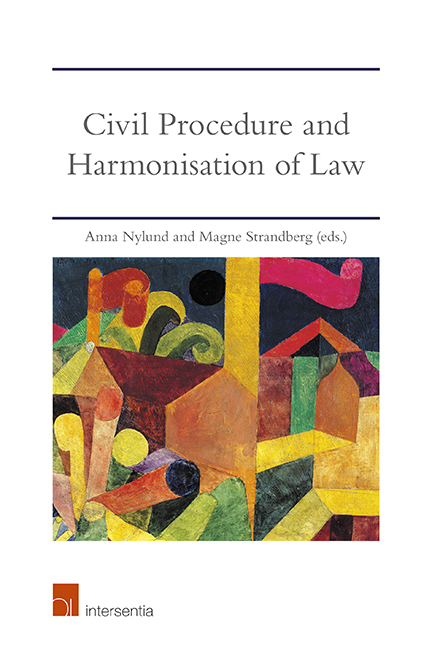Book contents
- Frontmatter
- Preface
- Contents
- List of Contributors
- List of Abbreviations
- Introduction
- EU Civil Justice at the Harmonisation Crossroads?
- The ELI-UNIDROIT Project: An Introduction and an English Perspective
- Europeanisation of Civil Procedure: Overcoming Follow-Up Fragmentation through Bottom-Up Harmonisation?
- Harmonisation or Fragmentation of National Law? An East Nordic Perspective
- An Examination of the Influence of European Union Law on English Civil Procedure
- The EU's Influence on Norwegian Civil Procedure through National Substantive Law
- Consumer Protection and EU-Driven Judicial Activism in the Netherlands
- The Role of the Judge in Consumer Cases – A German Perspective
- Ex Officio Application of the Unfair Terms Directive Cases against Consumers: A Swedish Perspective
- Ex Officio Application of EU Consumer Protection Law in Norwegian Courts
- Maintenance and Multi-Level Harmonisation: A European Union Perspective
- Family Maintenance and Multi-Speed Integration: A Norwegian Perspective
- Conclusions on Civil Procedure and Harmonisation of Law
- About the Editors
Family Maintenance and Multi-Speed Integration: A Norwegian Perspective
Published online by Cambridge University Press: 30 March 2019
- Frontmatter
- Preface
- Contents
- List of Contributors
- List of Abbreviations
- Introduction
- EU Civil Justice at the Harmonisation Crossroads?
- The ELI-UNIDROIT Project: An Introduction and an English Perspective
- Europeanisation of Civil Procedure: Overcoming Follow-Up Fragmentation through Bottom-Up Harmonisation?
- Harmonisation or Fragmentation of National Law? An East Nordic Perspective
- An Examination of the Influence of European Union Law on English Civil Procedure
- The EU's Influence on Norwegian Civil Procedure through National Substantive Law
- Consumer Protection and EU-Driven Judicial Activism in the Netherlands
- The Role of the Judge in Consumer Cases – A German Perspective
- Ex Officio Application of the Unfair Terms Directive Cases against Consumers: A Swedish Perspective
- Ex Officio Application of EU Consumer Protection Law in Norwegian Courts
- Maintenance and Multi-Level Harmonisation: A European Union Perspective
- Family Maintenance and Multi-Speed Integration: A Norwegian Perspective
- Conclusions on Civil Procedure and Harmonisation of Law
- About the Editors
Summary
FAMILY MAINTENANCE AND MULTI-LEVEL REGULATION
Globalisation, free movement of labour and migration affect regulations on judicial co-operation and cross-border proceedings in family matters, including family maintenance. Since the turn of the millennium, EU (procedural) family law has emerged as a field of law. The EU Maintenance Regulation was draft ed concurrently with the 2007 Hague Convention on maintenance, creating a direct link between EU law and international law. Before then, the Brussels regime on the jurisdiction and the recognition and enforcement of civil and commercial matters had a few provisions regulating family mediation. So did its parallel instrument, the Lugano Convention, which extends the free movement rulings to the entire single market, including European Free Trade Association (EFTA) states. Despite the fact that the Agreement on the European Economic Area (EEA) widens the single market and the four freedoms to states outside the EU, the development of family law in the EEA or EFTA has stagnated. International law and EU law on family maintenance have taken a leap forward and formed a connection. Simultaneously, the connection between EU law and EFTA law has weakened: the Treaty of Amsterdam has developed the competences of the EU, whereas EFTA law has maintained the status quo.
Currently, family maintenance is regulated on five levels: (1) on an international level through the Hague regime, (2) on an EU level, (3) on an EFTA level, (4) on a regional level, and finally (5) on a national level. The three first levels of law are interconnected and partially overlapping. However, a multi-level approach may be beneficial for regulating family maintenance in a multi-speed Europe. A multi-level, multi-speed approach may also increase complexity and opacity, creating an intricate web of regulation.
This chapter examines the interplay between instruments at different levels and discusses whether the relationships are constructive or disruptive. The existence of several levels of regulation results in complexity, yet the levels are complementary, filling lacunae. This chapter explores how different levels of law could be used to enhance integration of civil procedure, including the advantages and disadvantages of each level. The focus is on managing multispeed integration, where some countries are part of, or closely tied to, the single market, but do not participate in judicial co-operation.
- Type
- Chapter
- Information
- Civil Procedure and Harmonisation of LawThe Dynamics of EU and International Treaties, pp. 209 - 230Publisher: IntersentiaPrint publication year: 2019
- 1
- Cited by



